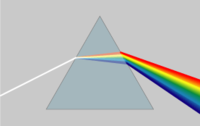
Photo from wikipedia
DOI: 10.1002/adom.201901951 fluorescence as a way to increase emission rates.[1] A wide range of (nano) photonic and plasmonic structures have also been employed for the same purpose, including optical cavities[2,3]… Click to show full abstract
DOI: 10.1002/adom.201901951 fluorescence as a way to increase emission rates.[1] A wide range of (nano) photonic and plasmonic structures have also been employed for the same purpose, including optical cavities[2,3] and nanoantennas.[4–15] A common feature of all these systems is the presence of resonant modes featuring hot spots of highly enhanced optical field intensity. When a radiation source (e.g., an oscillating electric dipole) is located at such hot spots, its emission rate is increased by an amount proportional to the local field-intensity enhancement. Under these conditions, the output light mostly originates from the excitation and subsequent radiative decay of the underlying resonant modes. As a result, its far-field properties (including directionality and polarization) are to a large extent determined by the nature of these resonances, rather than the original dipole sources. Suitably designed optical cavities and nanoantennas can therefore be used to enhance emission rates and at the same time control the far-field pattern of the output radiation. Significant additional degrees of freedom to engineer the same functionalities are also provided by tailored arrays of these optical elements,[16] including deterministic aperiodic arrangements.[17] In the context of beamed light emission, several remarkable demonstrations of this basic idea have been reported in recent years, but mainly limited to highly localized nanoscale sources (e.g., single quantum dots (QDs), molecules, nanowires), carefully positioned to optimally excite the resonant modes of a nanoantenna.[18–21] For extended-area light emitters (i.e., planar samples with microscale lateral dimensions, as used in typical optoelectronic devices), directional radiation patterns can be obtained with periodic structures such as photonic[22–25] or plasmonic crystals.[26–28] However, so far this approach has been largely limited to the generation of symmetric radiation patterns (with respect to the sample surface normal), due to identical contributions from equal and opposite diffraction orders. Asymmetric unidirectional light emission can be implemented by tailoring the shape of the unit cells of the periodic structure to introduce asymmetry in its diffraction response. Suitable geometries recently explored for this purpose include triangular nanoantennas[29] and asymmetric nanoparticle (NP) dimers.[30] Optical metasurfaces have been widely investigated in recent years as a means to tailor the wavefronts of externally incident light for passive device applications. At the same time, their use in active optoelectronic devices such as light emitters is far less established. This work explores their ability to control the radiation properties of a nearby continuous ensemble of randomly oriented incoherent dipole sources via near-field interactions. Specifically, a film of colloidal quantum dots is deposited on a plasmonic metasurface consisting of a 1D array of metallic nanoantennas on a metal film. The array is designed to introduce a linear phase profile upon reflection, and a bi-periodic nanoparticle arrangement is introduced to ensure adequate sampling of the desired phase gradient. Highly directional radiation patterns are correspondingly obtained from the quantum dots at an enhanced emission rate. The underlying radiation mechanism involves the near-field excitation of surface plasmon polaritons at the metal film, and their selective diffractive scattering by the metasurface into wellcollimated beams along predetermined geometrically tunable directions. These results underscore the distinctive ability of metasurfaces to control radiation properties directly at the source level, which is technologically significant for the continued miniaturization and large-scale integration of optoelectronic devices.
Journal Title: Advanced Optical Materials
Year Published: 2020
Link to full text (if available)
Share on Social Media: Sign Up to like & get
recommendations!